The current global trend in agriculture is the introduction of agricultural technologies for precision farming, the foundations of which were laid in the last century by academician I.S. Shatilov [1]. Methods and means of influencing crops with various chemical compositions are actively developed and implemented to control pests and increase the quantity and quality of the crop. Systems for monitoring the state of crops at all stages of growth and methods for managing yields are being developed and applied. The most striking example is modern Aero-hydroponic greenhouse complexes, in which the number of controlled parameters reaches its maximum. Ideal conditions for plants are created for temperature, humidity, nutrients, cycle and spectral intensity of illumination, which significantly increases the growth rate. However, significant amounts of crops are grown in fields whose combined area is so large that it can make up a large part of the territory of a single region. This fact makes it necessary to use mobile technical solutions that can provide monitoring and processing of a large area.
Purpose of research
Solution analysis and integration to tasks of agriculture and fire protection of farmlands and forests.
Materials and research methods
For this reason, trikes and small aircraft used in agriculture do not lose their relevance. These aircraft have a long range and load capacity, which allows you to process and control a large area. But it is worth noting that the cost of operating these funds is quite high [2].
Light aircraft such as “Snipe”, “SU-38”, “Spectrum”, “NARP” are in great demand. They are able to process more than 1000 hectares per day. For processing smaller territories, trikes equipped with special spray installations are actively used. Some models have been developed for this task. Among them, the most common are “T-2M CX”, “Wind”, “Vulture”, “Horizon”. At the same time, the productivity of such devices reaches 500 hectares per day. It should also be noted the dangerous effect of chemicals on a person piloting vehicles of this type.
Helicopters are also used to spray chemicals. Their distinctive feature is the accuracy of processing, which is greater than that of trikes and airplanes, and the effect on the sprayed substance by air flows from the propeller, which ensures an even distribution of the substance. The most affordable option today is the Robinson R44. Its productivity is 700 hectares per day.
It is quite difficult to implement the “precision farming” approach by the means listed above due to the significant speed of flight, the inability to hover in one place, etc. The exception is helicopters, but the cost varies around 40 thousand rubles per flight hour [3].
The rapid development of satellite and optical navigation technologies in recent years has led to a rapid increase in the number of unmanned aerial vehicles that are used in various fields of human activity. However, such drones are usually equipped with satellite navigation functions for determining the distance and automatic return, and optical navigation functions for hovering over a given point. Also, some models support the ability to follow the operator, which indicates the use of rather complex video processing algorithms in conjunction with control and positioning algorithms [4].
Obviously, this development and reduction in the cost of such devices have led to an increase in their number in professional fields. Currently, drones are being actively introduced into agriculture [4]. The above-mentioned optical and satellite navigation capabilities provide accurate positioning in a given area, for example, for processing the territory with various compounds in order to prevent crop diseases or control pests. And processing the image from the drone’s camera provides the ability to recognize a variety of signs, such as the spread of diseases or pests.
Examples of such multifunctional drones include the P4 Multispecial and Agras T16 models, which are manufactured by DJI. These models are applied according to the scenarios described above, thanks to a modern system of cameras of various spectrum and software algorithms for data processing (Fig. 1). At the same time, the P4 Multispecial flight time is up to 28 minutes and the signal transmission radius is up to 7 km, which allows you to inspect a significant area with minimal costs [5]. The characteristics of the Agras T16 drone provide the ability to control at a distance of up to 5 km and process an area of up to 10 hectares per hour [5].
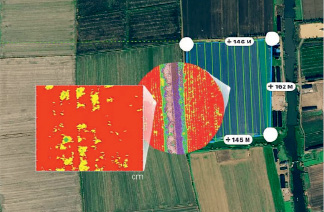
Fig. 1. Crop condition scanning with the DJI P4 Multispecial drone [5]
All this has also become possible thanks to the development of “battery technologies”, since the power source is one of the main elements of the drone. Its charge rate, duration of operation, weight and durability determine all the design solutions used. Currently available technologies provide the ability to fly within a few hours and a load capacity sufficient to place the necessary equipment on the drones. However, even with these characteristics, the restriction of the cultivated area makes it impossible to use them in remote or hard-to-reach places.
Research results and discussion
Airships can be a solution to this problem. Currently, this area is actively developing, new approaches are being developed that help to overcome the typical difficulties of managing in adverse conditions, improve safety and load capacity. It is also worth noting the direction of creating hybrid airships that combine the features of aircraft and airships.
The main advantage of airships is the minimum energy consumption for maintaining altitude, because by regulating the lift force, they are able to hover at a certain height due to the aerostatic effect, without reducing their load capacity. Due to this, the operating cost of the airship is approximately 1000 times lower than the operating cost of the helicopter, and the cost of production is 10 times less than the cost of production of the helicopter [3]. Another significant advantage is the fact that airships do not need specially equipped airfields to land and take off.
Hence their effectiveness in solving the problems of “precision farming”. Equipped with modern navigation equipment, sensors and cameras, the airship is able to follow the specified route as accurately as possible, measure parameters in individual sections of fields and scan them in various spectral ranges, while creating detailed maps with the coordinates of damaged areas. With a power reserve significantly superior to drones, airships can perform their functions over a large area.
At the same time, in the spring-summer-autumn seasons, i.e. during periods of intensification of agrotechnical processes of agriculture, crop production, horticulture and forestry, including due to the “human factor” and high air temperature, the probability of fires increases. The ability to detect a fire early and respond before the fire spreads over a large area would significantly reduce the damage and cost of fighting farmland and woodland fires. For this purpose, the devices described above could be used, which would combine agricultural technologies with early detection of fires, notification of fire services and fire extinguishing. Modern image recognition technologies allow you to find fires during the day and at night by analyzing the video stream from visible spectrum cameras and infrared cameras. The use of neural networks for this task provides real-time image processing, as well as high recognition accuracy [6].
At the same time, extinguishing forest and steppe fires from the air is most often carried out using fire-fighting aircraft or helicopters with special equipment.
The Russian emergencies Ministry has a large and well-equipped fleet of fire planes and helicopters. These include the world’s largest mi-26 helicopter, IL-76TD and BE-200 aircraft. The IL-76TD is equipped with 42,000 liter tanks and can empty them in 8 seconds. Its main advantage is the discharge of water in high concentrations. However, to fill the tanks, it needs to return to the airfield [7].
The BE-200 series aircraft, which have been delivered to the Ministry of emergency situations since 2012 in the form of the most modern modification of the BE-200ChS, do not have this disadvantage. Their main feature is the ability to fill the tanks with water for 16 seconds in the planing mode above the surface of the reservoir. In conditions when there is a reservoir at a distance of up to 10 km from the fire source, this aircraft is able to deliver 320 tons of water to the fire site in one refueling. Also, due to the possibility of refueling in reservoirs in the fire zone, “pauses” are reduced when extinguishing fires [7].
Fire helicopters MI-8MTV-1 and MI-26T perform the task of extinguishing the fire with greater accuracy. To do this, the helicopters are equipped with special external suspended spillways that are filled with water in the nearest reservoirs. The MI-8 can deliver up to 4 tons of water and discharge directly to the fire. The MI-26T is equipped with an APU-15 spillway and can deliver up to 15 tons of water to the fire site. At the same time, helicopters can transport personnel to the fire site or perform evacuation, as well as carry out effective extinguishing on terrain with difficult terrain, access to which is difficult for aircraft [7].
The main disadvantages of using helicopters and airplanes are significant costs, as well as the lack of reservoirs and airfields near the sites of fires and fires. These factors impose time restrictions on the extinguishing process itself, since the equipment needs time to refuel and move between the reservoir and the fire centers, as a result of which the fire has time to cover a large area.
Some models of airships have outstanding characteristics and could be used for firefighting and agricultural tasks after modernization. The most famous are the Airlander 10 of Hybrid Air Vehicles (Fig. 2, a), and the P-791 of Lockheed Martin (Fig. 2, b). Flying Whales is also working with the Chinese state-owned aircraft manufacturer General Aircraft Co., Ltd. to develop a promising airship with a rigid frame and a load capacity of 60 tons. Lockheed Martin is developing a hybrid airship LMH-1, which can carry 21 tons of cargo and up to 19 passengers, to solve the problems of transporting goods to remote regions where there is no prepared landing airfields . The Russian company “RosAeroSystems” was noted for the development of airships models Au-12 (Fig. 2, c) and Au-30 (Fig. 2, d), which have been successfully tested and are used for transportation and monitoring of emergency situations. There are known Russian studies on the development of a diving fire airship [8] and a fire airship with continuous water supply by a supply airship [9].
Due to the considerable duration of the flight, they can be used for patrolling hard-to-reach areas and detecting fires.
The solution to the problem of resupply of fire extinguishing agents is a promising method of extinguishing a fire using nanotechnology to extract atmospheric nitrogen from the air and supply it to the fire zone. The principle of extinguishing is to reduce the concentration of oxygen required to maintain fire in the fire zone [10, 11, 12]. The nitrogen membrane installation container can be attached to the airship and also serve as a mooring or landing device. It can be supplemented with structures for transporting firefighters and evacuating people. At the same time, the airship can hover over fire centers until they are completely localized and eliminated, moving from one to another (Fig. 3).
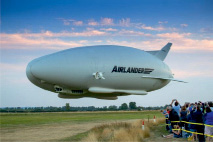
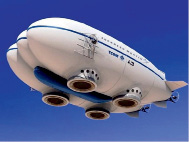
a) b)
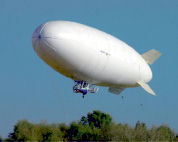
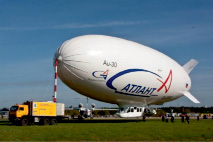
c) d)
Fig. 2. Hybrid airships a) Airlander 10, b) P-791, c) Au-12, d) Au-30
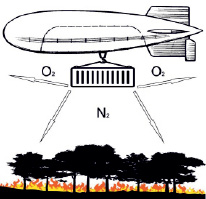
Fig. 3. Application of agro fire airship to extinguish a forest fire
Conclusion
Thus, the synthesis of all the advantages of airships and the method of extinguishing fires with atmospheric nitrogen is an ideal solution to the problem of extinguishing forest and steppe fires. In Russia, this is especially important, since most of the territory of woodlands is difficult to access, remote, and does not have the necessary infrastructure for the most effective use of other solutions.
The proposed combination of agricultural and fire-fighting functions makes it possible to increase the level of fire safety in agricultural regions by continuously monitoring the surrounding area while performing agricultural tasks with the possibility of early detection and extinguishing fires.

